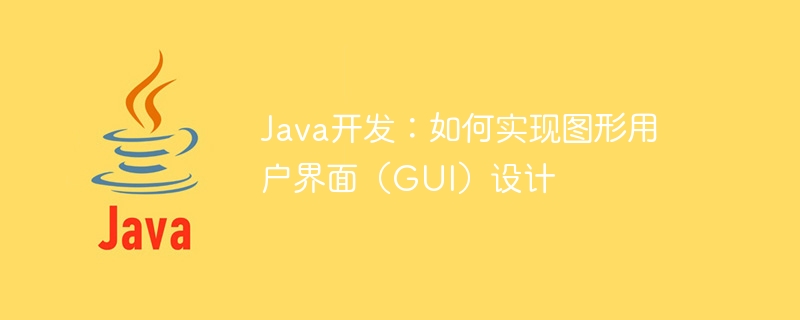Home >Java >javaTutorial >Java Development: How to Implement Graphical User Interface (GUI) Design
Java Development: How to Implement Graphical User Interface (GUI) Design
- PHPzOriginal
- 2023-09-20 13:41:051338browse

Java Development: How to Implement Graphical User Interface (GUI) Design
In modern software development, Graphical User Interface (GUI for short) has become One of the key factors of user experience. In Java development, rich GUI design can be easily realized using the graphics library provided by Java. This article will introduce you to how to use Java development tools to implement GUI design and provide specific code examples.
1. Basic principles of GUI design
Before we start to introduce GUI design, we need to understand some basic concepts and principles.
1.1 Component
In GUI design, all user interface elements are called components. Common components include buttons, text boxes, labels, etc.
1.2 Container
Container is a special component used to accommodate components, which can be understood as "boxing". Common containers include Window and Panel.
1.3 Layout Manager
The layout manager can be responsible for the position and size of components within the container. Common layout managers include Flow Layout, Grid Layout, etc.
2. Use Java Swing to implement GUI design
Java Swing is a set of class libraries provided by Java for creating GUI applications. Below we will use Java Swing to implement a simple GUI design.
2.1 Create a window
First, we need to create a window. The code to create a window is as follows:
import javax.swing.JFrame;
public class MyWindow {
public static void main(String[] args) {
JFrame frame = new JFrame("My Window");
frame.setSize(300, 200);
frame.setDefaultCloseOperation(JFrame.EXIT_ON_CLOSE);
frame.setVisible(true);
}
}In the above code, we use the JFrame class to create a window object and set the window size and title. At the same time, we also use the setDefaultCloseOperation method to set the default operation when the window is closed to exit the program.
2.2 Add components
Next, we need to add some components to the window. For example, we can add a label and a button. Modify the above code as follows:
import javax.swing.JButton;
import javax.swing.JFrame;
import javax.swing.JLabel;
public class MyWindow {
public static void main(String[] args) {
JFrame frame = new JFrame("My Window");
frame.setSize(300, 200);
frame.setDefaultCloseOperation(JFrame.EXIT_ON_CLOSE);
JLabel label = new JLabel("Hello World!");
JButton button = new JButton("Click Me");
frame.add(label);
frame.add(button);
frame.setVisible(true);
}
}In the above code, we first create a label object and a button object. Then, add them to the window using the add method.
2.3 Using the layout manager
By default, the layout manager used by JFrame is Border Layout. You can use other layout managers to specify the position and size of components. For example, we can use fluid layout to arrange two components horizontally. Modify the above code as follows:
import javax.swing.JButton;
import javax.swing.JFrame;
import javax.swing.JLabel;
import java.awt.FlowLayout;
public class MyWindow {
public static void main(String[] args) {
JFrame frame = new JFrame("My Window");
frame.setSize(300, 200);
frame.setDefaultCloseOperation(JFrame.EXIT_ON_CLOSE);
frame.setLayout(new FlowLayout());
JLabel label = new JLabel("Hello World!");
JButton button = new JButton("Click Me");
frame.add(label);
frame.add(button);
frame.setVisible(true);
}
}In the above code, we use the setLayout method to set the window's layout manager to fluid layout. This way, the components in the window will be arranged horizontally from left to right in the order they were added.
So far, we have successfully implemented a simple GUI design. You can see a window with labels and buttons while the program is running.
3. Summary
This article introduces you to the basic principles and steps of using Java development tools to implement GUI design. By using the Java Swing class library, we can easily create GUI applications with rich interactivity and user-friendliness. I hope this article will be helpful for you to learn and understand GUI design.
(Note: This article only provides basic concepts and implementation examples of GUI design. Specific GUI design methods and techniques require in-depth study and practice.)
The above is the detailed content of Java Development: How to Implement Graphical User Interface (GUI) Design. For more information, please follow other related articles on the PHP Chinese website!
Related articles
See more- Introduction to Java graphical user interface design (Swing)
- How to implement calculator applet in java gui
- How to use PHP for human-computer interaction and user interface design
- User interface design and optimization of PHP online voting system
- How to optimize the user interface design of PHP FAQ collection

